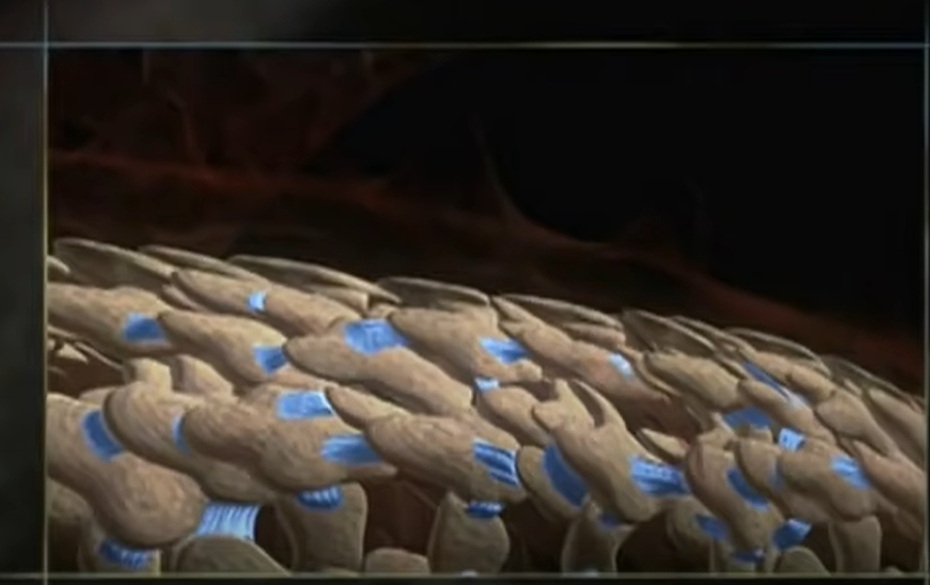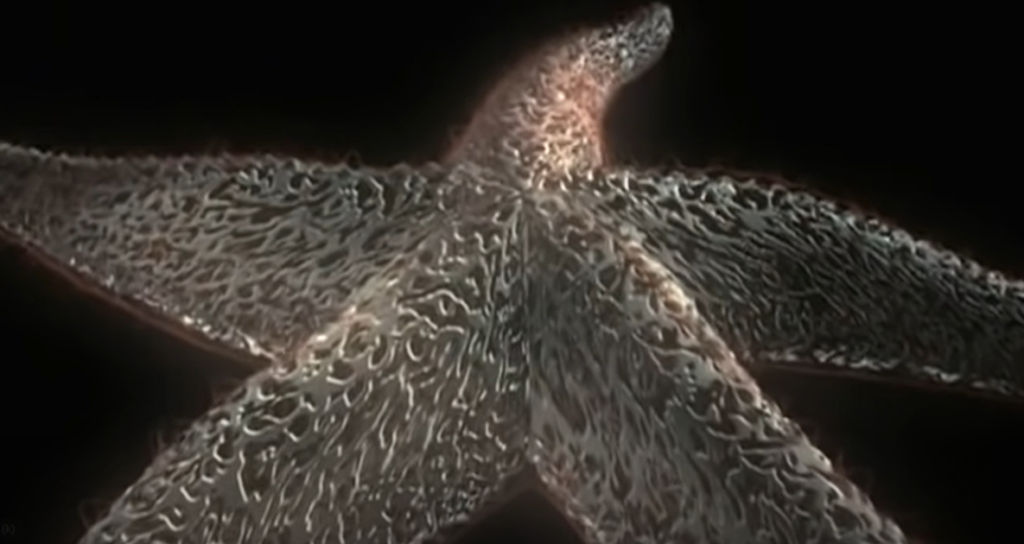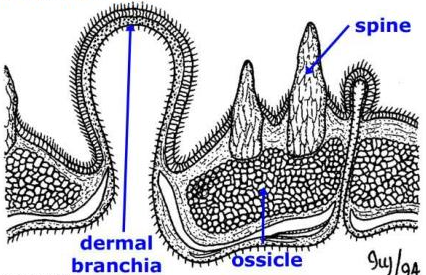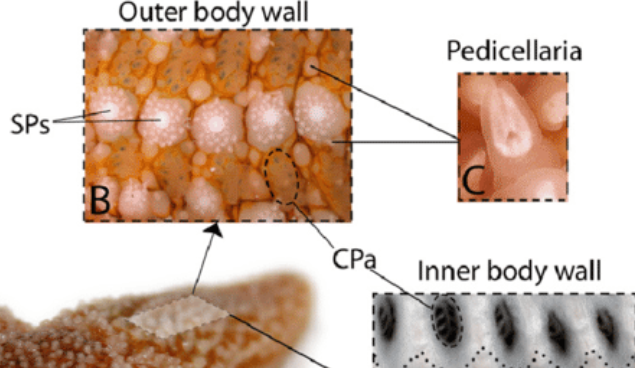Now we will continue with explaining this wonder of wonders called the starfish. In this article we will explain what is going on, on the top surface of the starfish. Below are a number of pictures which will help you to understand what’s going on. First, we start off with the skeleton. The skeleton is hard yet very flexible. It has a bunch of calcium plates attached by muscles. Since the plates (called ossicles) are not actually attached directly to each other, rather they are held together by muscles (collagen fibers), which gives them their ability to be flexible. This skeleton goes all across the stretched-out arms as well. See pictures. The blue in the below picture is of the muscles holding each plate next to the one nearby it. This allows for a lot of flexibility.


As you can see, even the plates themselves have holes in them. As we will see, it’s very important that the outside of the skeleton should be able to connect to the insides of the starfish. Why is that? So, we will now explain what’s on top of the skin (dermis) that surrounds the skeleton. This skin layer has three structures all over the skin and you will then understand. The most important structure is the Papulae (otherwise known as the Dermal Branchiae, otherwise known as the gills of the starfish.) These gills are all over the surface of the entire upper part of the starfish. They are crucial for the breathing of the starfish. Then there’s the spine structure. They actually don’t do much other than protect the gills by being a protrusion, like mountains, all around the gills, thereby protecting them. They are made of the same material that the skeleton is made of, so they are hard, thereby creating a good protection to the gills which are structures that are quite fragile. The last structure is the Pedicellaria. These are complex structures that are there to keep the surface of the skeleton clean so that the gills don’t get covered over with all types of debris and parasites. In species with larger pedicellaria, they are actually able to grab on to small fish passing by. So, now we will explain them, one by one.
The gills. (Dermal branchiae) The below picture is very important to enable us to understand how things work. You will notice that the gills are open at their bottom. What’s at their bottom? As you will see in the picture below this one, it shows that the skeleton has special holes in them, that the gills are directly on top of. BELOW those holes are the insides of the starfish. As we will explain, surrounding all the organs on the inside of the starfish is seawater. It’s not completely clear water, since it has important chemicals in it, and nutrition and its waste products are floating in it, as well as other important “stuff” floating in it. But, believe it or not, this water is like the blood of the starfish. The starfish has no blood and no heart. This water is where all the oxygen and CO2 – (carbon dioxide) is contained which will be distributed all over the body where needed. So, where does the important oxygen come from, and how does the poisonous CO2 leave the body? This picture shows the spines and next to the spine on the right is the pedicellariae. On the left is the gills (dermal branchiae or papulae). On bottom and on the sides are the ossicles which are the hard parts of the skeleton.

In the below picture you see the SPs. Those are spines. You also see the C showing the pedicellaria. The CPa that is circled (not much to see in this picture since they are pretty flat although many times they are higher up. In fact, the same gill can sometimes be flat (when not in use) and higher up when in use) is shown to be lying directly on top of the HOLES of the inner body wall, meaning the skeleton.

The way starfish breathe
The way starfish breathe and get their oxygen is through the gills. The gills are surrounded by very thin skin. The skin is obviously surrounded by seawater. Through a process that Hashem put into nature, called diffusion, oxygen gets into the gills. Without going into details, it means that the oxygen molecules in the seawater can seep through the skin of the gills and then it goes into the water of the gills which are connected to the reservoir of water that is on the inside of the body cavity. The main body of water in the body cavity now has oxygen which will be circulated around the body. CO2 produced from the many cellular processes that the starfish is engaged in, are then released through the gills OUT into the surrounding seawater also through the method of diffusion. That’s how starfish get 80% of their oxygen. Where’s the other 20% from? Believe it or not, drumroll please…, it’s through the thin skin of the tube feet! The very thin skin of the tube feet also has diffusion going on through them. The oxygen enters from the seawater through its skin, into the water in the tube feet and eventually that water will get back to all the water that is connected to the reservoir of the body cavity, just like it works with the gills! One last point for this article. If you look at the previous picture you will notice little hairs coming out on the outer layer of skin and from the inner layer of skin, and pretty much all over the place as this picture depicts. These are cilia. Cilia move like an oar in wavelike motions. Cilia are MUCH more complicated than they look. There’s nothing in Hashem’s world that’s really simple. The cilia all over the top of the surface of the starfish are needed to move the water around. If the water stays still (as the starfish is often still for quite a while) then the water near it will get full of CO2, and the gills need fresh water near them in order to get a fresh oxygen supply. The cilia also help in sensing what is going on all around the starfish. There are cilia in the central cavity of the starfish all over the walls in order to move around the water in the reservoir so that all the nutrients and oxygen and other important elements in the water get around to all the places that they are needed. These cilia are essential in a number of different processes of the starfish. All these functions are anything but an accident, wouldn’t you agree?!
To be continued.
About the Author
Rabbi Shmuel Waldman, a distinguished educator in the Jewish community, has spent over 50 years immersed in religious study and teaching. Deeply influenced by Rabbi Avigdor Miller ZTL and closely connected to Rav Don Segal, shlit”a, Rabbi Waldman began his journey at Mirrer Yeshiva and later became the Mashgiach at Yeshiva Mercaz Hatorah of Belle Harbor. His book, Beyond A Reasonable Doubt: Convincing Evidence to the Truths of Judaism, published in 2002, has sold tens of thousands of copies and is highly regarded in the world of kiruv, offering clear insights into Judaism’s fundamental beliefs. Rabbi Waldman’s impact extends to his teaching at Yeshiva Tiferes Moshe and various summer camps, where he inspired countless students. Recently, he has been focused on a major Sefer about the importance of proper prayer, while also creating a blog and YouTube channel that address Intelligent Design and challenge the Theory of Evolution. Rabbi Waldman’s work continues to influence and educate both students and broader audiences.